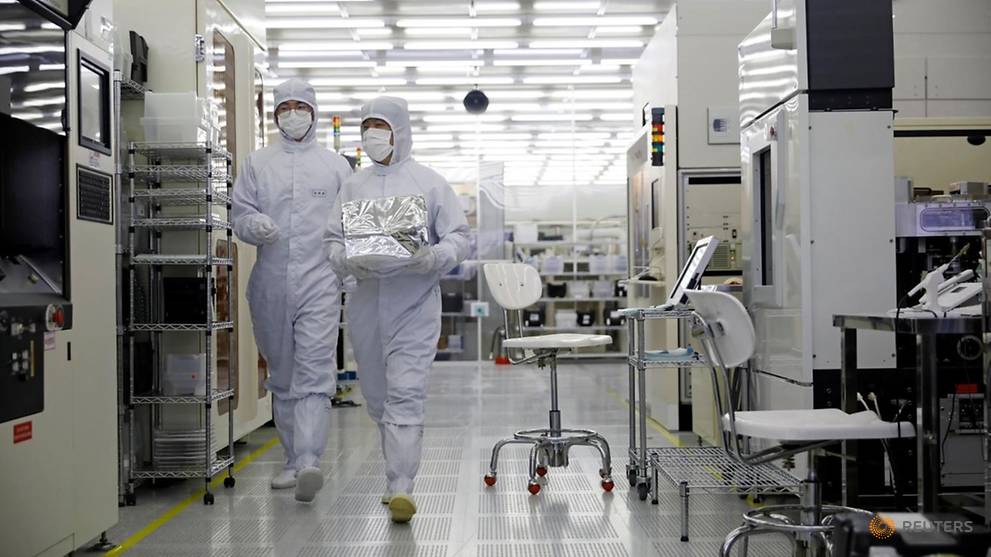
South Korea government, Samsung team up for self-sufficiency after Japan export curbs on chip material
DAEJEON, South Korea: When the South Korea government unveiled an expanded semiconductor material testing facility last month, the centrepiece was a towering white machine given by Samsung Electronics at a fraction of its market price.
The facility, aimed at motivating local suppliers to make and test sophisticated chip-making materials like photoresist, comes as South Korea pushes for self-sufficiency after Japan last year imposed export curbs on high-tech chip materials.
While industry sources warn Korea has a long way to go to achieve this, the need for self-reliance in chip technology has become more critical with the outbreak of the coronavirus pandemic and US-China tensions threatening to accelerate supply chain shifts.
Large chip-making companies like Samsung would previously source the best components at the cheapest price "no matter where the material was from", said Lee Jo-won, president of the National Nanofab Centre, home to the testing facility.
"But due to Japan's export curbs and COVID-19, they have begun to ... foster local suppliers and to create a system where they can be supplied without disruptions," Lee told Reuters at the centre in Daejeon city, 150km south of Seoul.
The equipment that Samsung sold to the lab, the ArF immersion lithography machine made by ASML, will help local suppliers test chip material.
The machine, which the world's top memory chip-maker had been using in its production line, costs up to 100 billion won (US$84 million) when new, experts said.
A National Nanofab Centre official said about 20 billion won had been budgeted to buy and refurbish the machine, without giving details on the final price.
"This would never have been imaginable in the past, to provide such an expensive device to a public lab," said Lee Jong-ho, a professor at Seoul National University.
"It took a decision from pretty high up."
SHORING UP BUSINESSES
Samsung has decided to invest in firms that need cooperation to develop next-generation chip technologies, a company spokesman told Reuters in an email.
It recently invested a total of about 113 billion won in two local makers of chip components and testing equipment, S&S Tech and YIK, its first such investments in three years.
S&S makes mask blanks, a chip-making component that is currently more than 90 per cent sourced from Japanese firms like Hoya but not included in export curbs.
"Samsung seems to be securing various options so they're not too dependent on any one source", said an official at a Samsung-backed chip material supplier.
With no sign of a thaw in South Korea-Japan tensions, rooted in wartime history, Seoul is pushing to diversify supply sources of 100 items it still mainly gets from Japan and has pledged to invest 5 trillion won by 2022 to that end.
READ: Commentary: How a century-old dispute between Japan and South Korea threatens the global supply of smartphones
South Korea has already diversified sourcing for the three materials targeted by Japan in the curbs last year and now gets supplies locally and from Belgium, Taiwan and China.
SCEPTICISM
But there is scepticism about whether it makes economic sense for Korea's small domestic chip material market to pour money into developing sophisticated technology in which Japan has a competitive edge, industry experts said.
Also, Seoul wants big corporations to use local suppliers, "but this is not an easy option unless quality is guaranteed", said Kwon Hyeok-min, leader of an industrial policy team at Korean business lobby group, Federation of Korean Industries.
Samsung, SK Hynix and LG Display supply chips and displays to tech giants like Apple, Qualcomm and Huawei.
The chip sector accounts for 20 per cent of exports for South Korea, Asia's fourth-largest economy.
It will take time to localise high-tech materials like EUV photoresist, former Hynix engineer Kim Sang-yong said. Japan accounts for 90 per cent of the global photoresist production.
Photoresists, which Japan targeted in its curbs that it later partially reversed, are thin layers of material used to transfer circuit patterns onto semiconductor wafers.
Kim, now a professor at Korea Polytechnics University, also cautioned South Korea could be hit hard should Japan expand curbs to chip-making equipment.
Out of South Korea's 100 import items heavily dependent on Japan, 14 are semiconductor-making equipment that are not subject to any restrictions, according to the Seoul-based Institute for International Trade.
If Japan extends curbs to these 14, South Korea's "chip production will stop", Kim said.
"What is more vulnerable than materials are the equipment and parts that manufacture semiconductors."